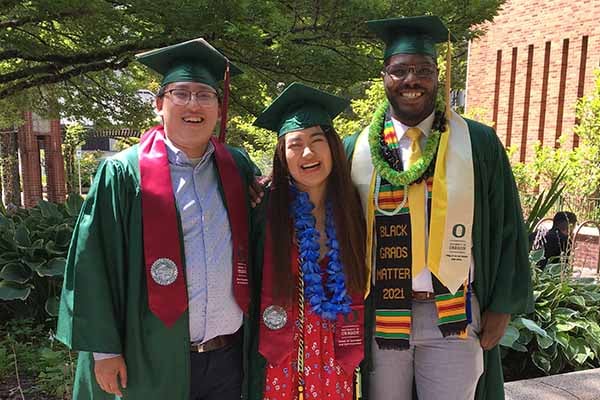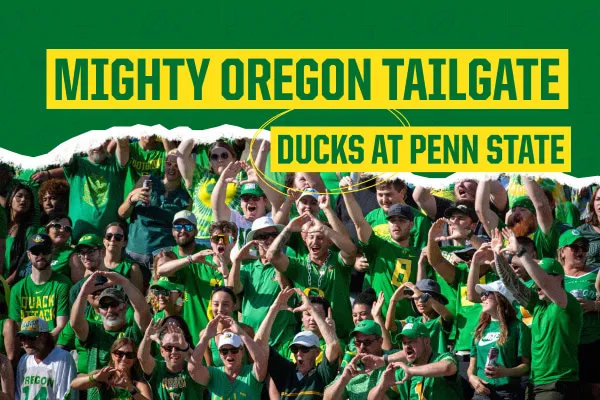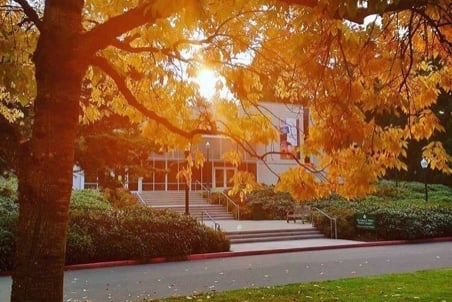
The dormitories of then, the residence halls of now
Over the years, the UO Eugene campus has grown exponentially. What was once a single building open to 177 students has now expanded to 295 acres serving a population of more than 23,000 students.
Every year, the number of incoming students increases, pushing the limits of housing capacity. To address this, the UO announced a major project in 2019 to build new residence halls that could accommodate the growth of the student population. The three-phase project is now nearing completion, and for Duck alumni whose children are now attending the UO, this means that campus looks different from what they experienced as a student.
Two of the most nostalgic yet least-updated residence halls, Hamilton Hall and Walton Hall, are being replaced by three new buildings, a student recruitment and welcome center, and an expansive green space. DeNorval Unthank Jr. Hall, named for the UO’s first Black graduate of the architecture program, opened in 2021. Two new residence halls—one with more traditional double and triple rooms and another offering apartment-style housing—will open this fall.
Though most UO alumni are thrilled to see new resources and state-of-the-art technology being prioritized for the next generation, many who come to campus still miss the days of old. With that in mind, let’s take a look at some of the memories made in residence halls at the UO over the past fifty years.
A Blast from the Past:

In the 1970s, there were five major residence halls (then called dormitories) on campus—three of which are still housing students today! Though Hamilton and Walton have been replaced by new infrastructure, Earl Hall, Carson Hall, and Bean Hall (now Justice Bean) have been renovated over the years and are still top choices for housing for incoming students. Barnhart Hall (previously University Inn) also became a popular housing choice after the university acquired the building in 1975.
Students of the 1970s experienced the tail-end of the UO’s mid-century architectural exploration and prompted many of the UO’s progressive views on campus housing. The ’70s saw residence hall championships, the introduction of the UO’s first successful coed dormitory, Deutsches Haus, and the first dorms that allowed drinking for students over twenty-one. Campus became the setting of the iconic movie Animal House in 1977 and the Autzen Footbridge was built, expanding access to the stadium over the beautiful Willamette River.
Some 2,800 students lived on campus then, a number that has now doubled, and enjoyed dorm parties, midnight trips to McDonald’s, and playing frisbee out of dorm windows. They were a humorous group, going so far as to elect the university president, Billy Boyd, as president of Tingle dormitory and hosting a dinner in his honor. Students of the ’70s were also highly altruistic, and often gave back to the local community, such as through donating jack-o-lanterns to Sacred Heart Hospital in 1976.
The ’70s and early ’80s were also fraught with national tensions between the US and Vietnam as well as Cold War consequences. The UO underestimated the number of students who would commit to the university, and both dorm rooms and food were in short supply. When unemployment in Oregon rose to a whopping 12.3% in 1983, the UO turned to fundraising for financial support. A fundraising initiative called “Campaign for Oregon” was inaugurated in 1989, with Phil Knight being a major contributor. That initiative, alongside others, is part of what has made all of the current renovations possible.
By the time the ’90s came around, most halls were coeducational and special interest halls were introduced. Common areas contained color television, table tennis, vending machines, computer terminals, and even more technology that prior generations had never heard of. Reduced-rate and weekend long-distance telephone was available from residence hall rooms through the university telephone system and both the Knight Law Center and the Moshovsky Sports Center were built during this time.
In recent years, Global Scholars Hall (2012) and Kalapuya Ilihi Hall (2017) were also added to campus.
What Comes Next?

As the UO finishes the Hamilton-Walton Transformation Project and we welcome new President Karl Scholz, university housing stays committed to enhancing the student experience. According to the UO Housing website, living on campus is students’ chance to meet friends, connect with faculty, and live in a place where they are supported, because the environment in which students choose to live is just as important as where they choose to learn.
It seems that this is a sentiment that has been shared throughout the generations, as in the 1975 Oregana, where one writer had this to say about the atmosphere of dorm living: “It is one of openness, and a discovery of the educational values in living with people of other interests, backgrounds and ages. The dormitory lifestyle offers unique advantages in personal interaction, convenience and service.”
As parents and alumni visit campus, we hope that they will fondly remember their time living on campus and look forward to the ways university housing will evolve for their children and future generations.
Most of the information for this article was collected through the University of Oregon Libraries’ archives, which has diligently been recording the history of the UO since its inception.








